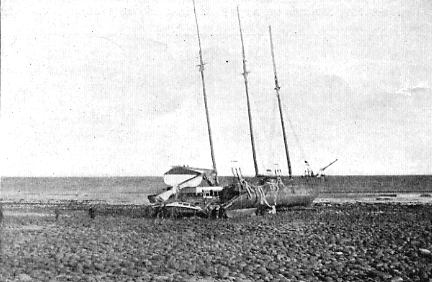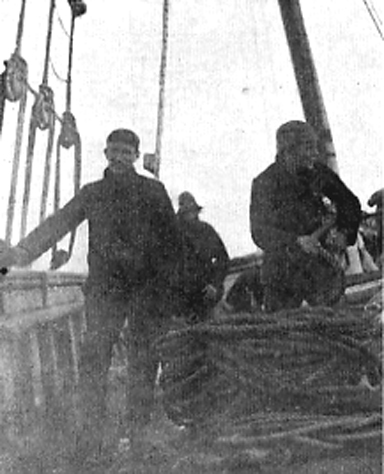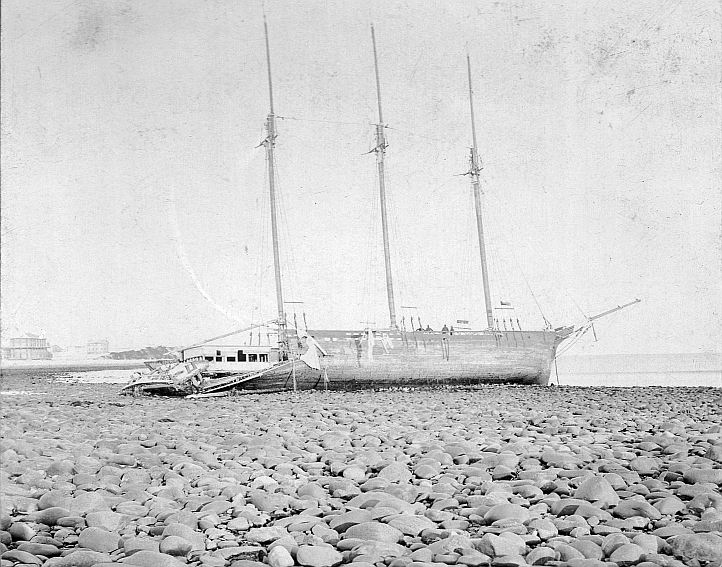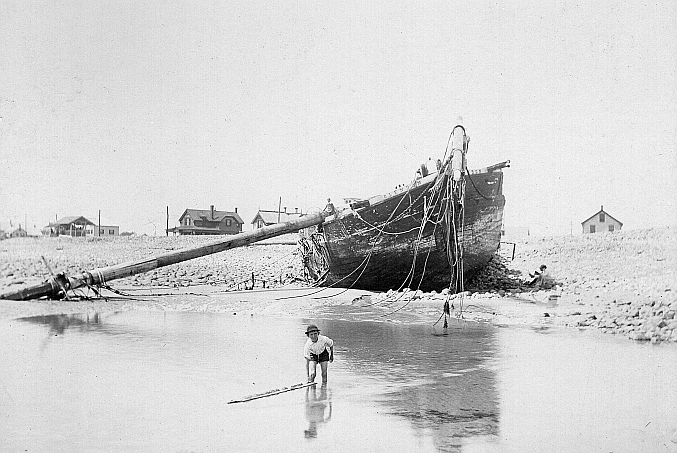Hampton Beach, N.H., February 1896
By Harry V. Lawrence
One Sunday afternoon, late in the month of February, 1896, the writer was seated in the telephone, exchange located at Exeter, N. H., when suddenly a call came in over the wire from Hampton Beach to get the lifesavers from Wallis Sands and Straw’s Point. The telephone operator immediately connected up with Portsmouth, and the operator in that city got the life-saving stations on a private line maintained by the government. Leaving the telephone office and getting the proprietor of a local hotel to harness up his trotter to a two-seated pung [a sleigh] was the work of a very few minutes, and then we started on our ten-mile drive, after inviting another man to accompany us to the wreck. We had driven about two miles when we began to drag on our runners, as the strong northeast wind had swept the road bare of snow in many places. At the Exeter House, we made a quick change, and took the proprietor’s buggy
Under the Bow Can be Seen Great Boar’s Head
Starting out in the storm once more, we drove as fast as we could for the next five miles. The snow was falling very fast now, and three miles from the beach we met the life-savers on their way to the wreck. They had their surfboat mounted on wheels and four horses were drawing it at a fair speed, although it seemed to be rather tough work for the animals. We arrived at the beach about thirty minutes ahead of the life-savers and it seemed as though the “northeaster” was trying to blow over the high bluff, “Great Boar’s Head.” We immediately unharnessed our horse, put him in a nearby barn, and then waited for the arrival of the surfmen. In a short time they put in an appearance and we had the opportunity of watching the splendid work of life-saving crews at a wreck for the first, and probably the last time in our lives.
A short distance from the shore, a large three-masted schooner was dragging its anchors and slowly but surely being driven in upon the jagged rocks that lined the coast at this point.

The northeast wind was getting in its deadly work upon this helpless vessel. At first we could see the light from a lantern on the deck but in a short time this light disappeared, and we knew that the crew were having a hard time aboard that boat. While we had been watching the schooner in its struggle with the tempest, the life-savers had rigged up their apparatus for shooting a line over the wreck. They fired several times and got lines to the rigging but the crew had taken to the “cross-tree” on the main-mast, and could not reach these lines from their perilous position. In a short time, the life-saving captains decided to change their position and try again from another section of the beach. In the meantime, the unfortunate crew aboard this vessel were lashed to the rigging, and it was a discouraging sight to see brave men so utterly helpless.
By this time, the officials of the town of Hampton had sent cordwood and oil to make a large fire and after this fire had been burning a short time, one could see the oil suits worn by the schooner’s crew. In a few minutes, we heard a sailor calling from the wreck, “For God’s sake get us out a line, we’re breaking apart.” The life-savers were now working as fast as they could to get a line to these discouraged sailors. Shot after shot was fired and one of the surfmen would pull back the line hoping against hope that he would feel an answering tug from the wreck. The life-savers were beginning to get discouraged themselves, and they had begun to talk about using the surfboat, although it was known that it would be an extremely dangerous trip to make on such a night. All kinds of wreckage was coming ashore and we picked up hats, books and even half of a life-preserver with the name Glendon painted on its side.
Suddenly the surfman nearest the water felt a tug on the other end of his line and we all knew that the shipwrecked crew had a fair chance to reach the shore. When this surfman cried out, “They’ve got her,” a thrill went through that little knot of people who were trying to help the brave sailors on that vessel. One of the surfmen with a very powerful voice cried out, “Have you got that rope?” Back across that stormy sea came the answer, “All right.” It was very dark now and some men started up the fire again so the life-savers could have plenty of light to carry on the hard work ahead of them. The strong “northeaster” was driving the waves completely over the decks and it was a sad sight to see this vessel being ground to pieces on the rocks. After a short delay, the sailors on the wreck pulled out a larger rope and then the big “hawser” with the “breeches-buoy” attached was pulled out and fastened to the main-mast.
When all was ready the crowd assembled on the beach, took a firm grip on the big “hawser” as it was not necessary to use the “sand-anchor” on account of so many men volunteering to hold the large rope. The crowd of men who had their hands on that rope was made up of life-savers, fishermen, sailors, clam-diggers, hotel proprietors, town officials and even boys. When all was ready, one of the surfmen started to pull in the “breeches-buoy,” and when this life-saving device came over the rope toward us we saw that it contained a sailor and just before this man landed on the beach he cried out to the life-savers, “Hello, boys, great night out.” Six more trips were made by the “breeches-buoy” and each trip brought a sailor to the shore. The last trip brought the captain, and he was in a rather bad condition as he had fallen down into the hold of his vessel earlier in the evening and had to be assisted up to the “cross-tree” where he hung on with his crew for several hours.

Note:–The Glendon was a coal-carrying schooner and was originally a steamship. The U.S. Government established a life-saving station at the Hampton Beach and it was the wreck of the Glendon that brought about the building of this station.
From:Granite Monthly, April 1911
See also this related article: Hampton Fisherman Finds Anchor-Chain Of A Lost Schooner


